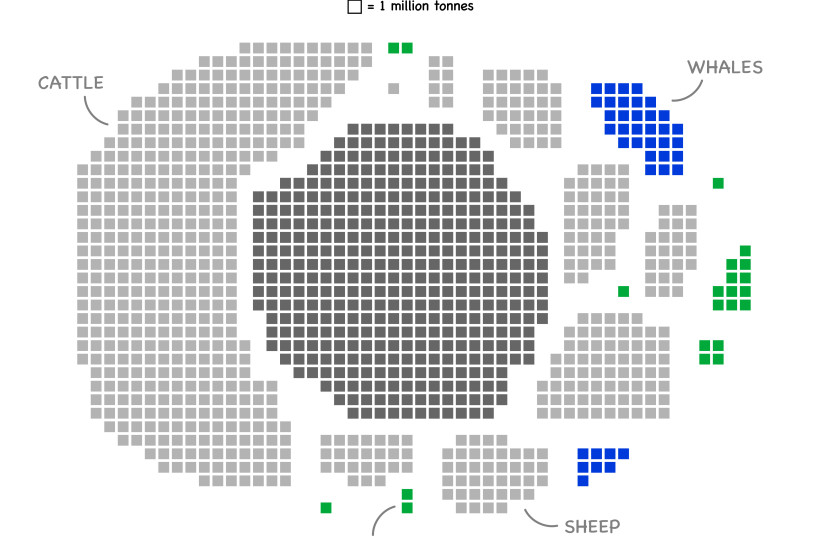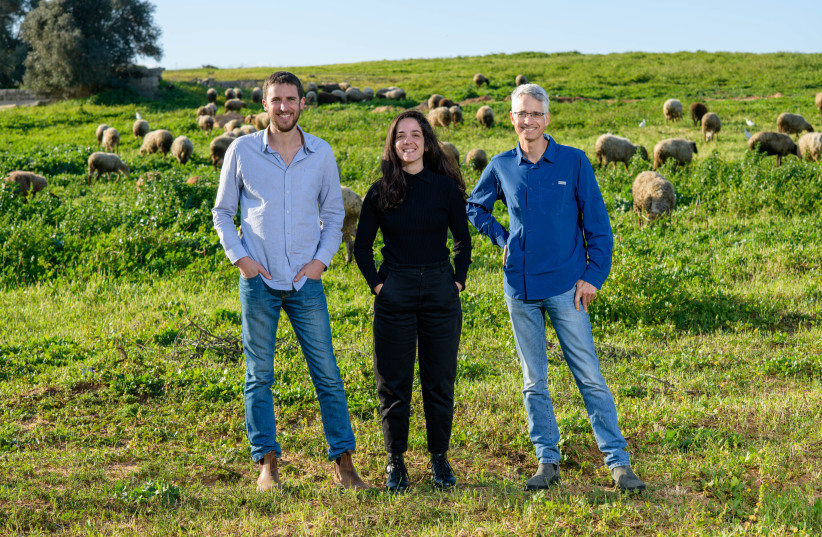We often think that our world is an infinite realm comprising great plains, jungles and oceans teeming with wild animals featured in memorable nature shows like the BBC’s Planet Earth and the TV channel National Geographic Wild.
However, the first global census of wild mammal biomass, conducted by researchers at the Weizmann Institute of Science in Rehovot, reveals the extent to which our natural world – along with its most iconic animals – is vanishing. The research was reported in the journal PNAS Proceedings of the [US] National Academy of Sciences under the title “The global biomass of wild mammals.”
Biomass of domesticated and wild animals
The new report shows that the biomass of wild mammals on land and at sea is dwarfed by the combined weight of cattle, pigs, sheep and other domesticated mammals. A team headed by Prof. Ron Milo found that the biomass of livestock has reached about 630 million tons, 31 times the weight of all wild terrestrial mammals (approximately 20 million tons).
One ton is 907 kilos or 2000 pounds.
Another earlier, widely-discussed study conducted by researchers in Milo’s lab at Weizmann’s plant and environmental sciences department showed that in 2020, the mass of human-made objects – anything from skyscrapers to newspapers – had surpassed the planet’s entire biomass, from redwood trees to honeybees.

In the latest study, the researchers offer a new perspective on humanity’s rapidly increasing impact on our planet, seen in the ratio between humans and domesticated mammals and wild mammals.
“This study is an attempt to see the bigger picture,” Milo asserted. “The dazzling diversity of various mammal species may obscure the dramatic changes affecting our planet. But the global distribution of biomass reveals quantifiable evidence of a reality that can be difficult to grasp otherwise. It lays bare the dominance of humanity and its livestock over the far smaller populations of remaining wild mammals.”
The study's methods
To calculate the biomass of our warm-blooded class, the researchers collected existing censuses of wild mammal species and the defining characteristics of hundreds more. Research students Lior Greenspoon and Eyal Krieger led the study’s translation of the accumulated information into biomass estimates. The collected censuses yielded data on about half of the global biomass of mammals. The team calculated the remaining half using a machine-learning computational model that had been trained on the initial half and that incorporated multiple parameters, including individuals’ body weight, area distribution, nutrition and zoological classification.
The analysis showed that human influence also strongly affects the relatively limited remaining mammalian presence in nature. Many of the wild mammals at the top of the biomass chart, such as the white-tailed deer (known to many from the animated Disney movie Bambi) have the largest biomass of all wild land mammals, and the biomass of pigs alone is nearly double that of all wild land mammals.
Wild boar arrived in Israel partly as a result of human activity and have now overrun parts of Haifa among other places.
Fin whales have the largest biomass of all marine mammals. Sperm whales and humpbacks hold the second and third slots, respectively.

Biomass studies offer a different perspective on the animal world compared to other metrics. For instance, the 1,200 species of bats account for a fifth of all land mammal species and two-thirds of all wild mammals by headcount (total number of individuals, but they make up only 10 percent of the biomass of wild land mammals.
The new study’s estimates of biomass ratios may help to monitor wild mammal populations globally and to assist in evaluating the risk posed by diseases that spread from animals to humans – a dynamic that many epidemiologists warn will continue to generate epidemics.
For humanity, wild mammals are an inspiration, and they often serve as icons encouraging nature conservation efforts. To better understand human impact on the environment, scientists in Milo’s lab are now analyzing how mammalian biomass has changed over the past century. “I find it important to understand, for example, when exactly the combined weight of domesticated mammals surpassed that of wild ones,” said Greenspoon. “A better understanding of the human-induced changes can help set conservation goals and afford us perspective on long-term global processes.”
“The more we’re exposed to nature’s full splendor – be it through films, museums or eco-tourism – the more we might be tempted to imagine that nature is an endless and inexhaustible resource. In reality, the weight of all remaining wild land mammals is less than 10% of humanity’s combined weight, which amounts to only about 2.7 kgs of wild, land mammals per person,” Milo explained. “In other words, our research shows, in quantifiable terms, the magnitude of our influence and how our decisions and choices in the coming years will determine what’s left of nature for future generations.”
In reality, the weight of all remaining wild land mammals is less than 10% of humanity’s combined weight, which amounts to only about 2.7 kgs of wild, land mammals per person.”
Dr. Ron Milo
The global distribution of mammals and their biomass can also serve as a step toward assessing future risks from emerging zoonotic diseases, the scientists wrote. “In the past century, many of the viral epidemics spread by viruses, including HIV, Ebola and, most recently, SARS-CoV-2, crossed from wild mammal carriers to humans. Other viruses, such as the H1N1 influenza A virus (commonly known as “swine flu”), crossed from livestock to humans. A joint estimate of the geographic distributions of wild and domesticated mammal biomass can be informative in assessing and monitoring zoonotic disease reservoirs.”
Other participants in the study include Uri Moran, Dr. Ron Sender, Dr. Yuval Rosenberg, Dr. Yinon M. Bar-On, Tomer Antman and Dr. Elad Noor of Weizmann’s Plant and Environmental Sciences Department; Prof. Shai Meiri of Tel Aviv University (TAU); and Dr. Uri Roll of Ben-Gurion University (BGU) of the Negev in Beersheba.
